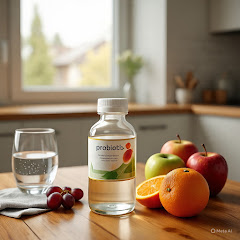🧬 The Biotech Behind Everyday Things: From Papaya to Perfume.
When we think about biotechnology, images of scientists in white coats and complex DNA sequences usually come to mind. But the truth is, biotech isn’t just limited to high-tech labs or futuristic medicine — it’s quietly present in your everyday life, often in ways you’d never expect.
From the fruit you eat in the morning to the fragrance you wear, biotechnology is working behind the scenes to make things healthier, cleaner, and more sustainable. Let’s take a closer look at the incredible biotech innovations behind the things you use every day — starting from your plate and reaching all the way to your perfume shelf.
🍈 Papaya: The Virus-Fighting Fruit
You might think of papaya as just a refreshing tropical fruit loaded with vitamins. But it’s also a quiet biotech success story.In the 1990s, Hawaiian papaya farms were being wiped out by a devastating Papaya Ringspot Virus. Conventional farming couldn't stop it, and the future of papaya farming looked bleak.That’s when scientists stepped in and used genetic engineering to develop a virus-resistant variety called the Rainbow Papaya. By inserting a small piece of the virus’s own genetic material into the papaya, the plant gained resistance — like giving it an immune system boost.
Thanks to this biotechnological advancement, papaya farming was saved. Today, the Rainbow Papaya continues to thrive, showing how genetically modified organisms (GMOs) can play a positive role in sustainable agriculture.
🟢 Biotech insight: Genetic modification can protect crops, reduce pesticide use, and boost food security.
🧼 Enzymes in Your Detergent
Ever noticed how your laundry detergent works so well even in cold water? That’s not just chemistry — it’s biotechnology in action.Most modern detergents contain enzymes that help break down stains:
Proteases for protein-based stains like blood or food
Lipases for greasy, oily marks
Amylases for starchy messes
These enzymes aren’t just scooped out of nature. They’re produced using genetically engineered bacteria and fungi, grown in huge fermentation tanks. This makes production more efficient and environmentally friendly. Plus, enzyme-based detergents are biodegradable, reduce water and energy use, and are gentle on fabrics — all thanks to industrial biotechnology.
🌸 Perfumes Without the Flower Fields
Your signature fragrance may smell like fresh roses or vanilla pods, but chances are, it didn’t come from a flower at all.Thanks to synthetic biology, companies now use engineered yeast or bacteria to produce fragrance molecules like vanillin (vanilla), rose oxide, and musk compounds — all without ever needing to grow the plant.This process is not only eco-friendly, but also cruelty-free and consistent in quality. It avoids overharvesting of rare flowers or harming animals (as was the case with traditional musk).
🟢 Fun fact: These lab-made scents are chemically identical to their natural counterparts — your nose can’t tell the difference!
🧃 Clearer Juice, Thanks to Pectinase
Ever wonder why some fruit juices look perfectly clear, while others are cloudy? The answer lies in a biotech-derived enzyme called pectinase.
Pectinase breaks down pectin — a natural compound that makes fruit juices cloudy. By adding this enzyme during processing, manufacturers get clearer, more shelf-stable juice.
These enzymes are typically produced by engineered microbes, making the entire process cost-effective and scalable. It’s a simple example of food biotechnology quietly working to enhance your drinking experience.
💉 Insulin, Revolutionized

For people with diabetes, insulin is a life-saving medicine. But before the 1980s, insulin was extracted from the pancreases of pigs and cows — a slow and imperfect process.
Then came a biotech breakthrough. Scientists inserted the human insulin gene into E. coli bacteria, creating the world’s first recombinant DNA medicine. These bacteria could now produce human insulin — safer, more effective, and more accessible.
This development marked a turning point for biopharmaceutical biotechnology, and millions of people now benefit from this innovation every day.
🧀 Cheese Made with Engineered Enzymes
Cheese lovers, here’s something you might not know: many cheeses today are made without traditional animal rennet. Instead, they use chymosin, an enzyme produced by genetically modified fungi.
This not only makes cheese vegetarian-friendly, but it also allows for more consistent cheese production and reduces dependency on animal sources. Another everyday win for food biotech!
🦠 Probiotics: Engineered for Your Gut
Probiotic products like yogurt, kombucha, and kefir are already packed with good bacteria. But biotech is taking it further.
Researchers are now engineering probiotics to do even more — like targeting inflammation, delivering therapeutic molecules, or even improving mental health through the gut-brain axis.
The future of microbiome science is here, and it starts with what’s in your fridge.
🌿 Eco-Cleaners Powered by Microbes
Some cleaning products now contain live bacteria or enzymes designed to break down grease, soap scum, and even harmful chemicals. These biotech-based cleaners are safe for septic systems, reduce chemical runoff, and are gentler on your skin and the environment.They’re an example of environmental biotechnology creating sustainable alternatives to traditional cleaning solutions.
💡 Final Thoughts: Biotech is Everywhere
Biotechnology isn’t just about curing diseases or inventing new life forms in a lab. It’s already shaping your world — your food, your health, your cleaning habits, and even your perfume.
Whether it’s a GMO fruit that saved a farming industry or a bioengineered enzyme making laundry easier, biotech innovations are helping us build a future that’s smarter, more efficient, and more sustainable.
So the next time you drink a clear apple juice or spritz your favorite scent, remember — you’re experiencing the power of biotechnology.
Stay tuned for more such amazing content🌟









Very informative, Good work Prapti
ReplyDeleteGreat work
ReplyDeleteVery insightful article
ReplyDeleteGood 👍🏻
ReplyDeleteVery informative👍🏻nice work keep it up.
ReplyDeleteVery nutritious talk
ReplyDeleteWell that was quite impressive, great work prapti
ReplyDelete